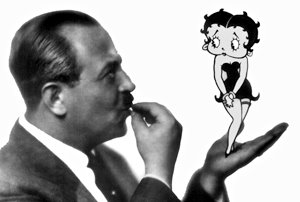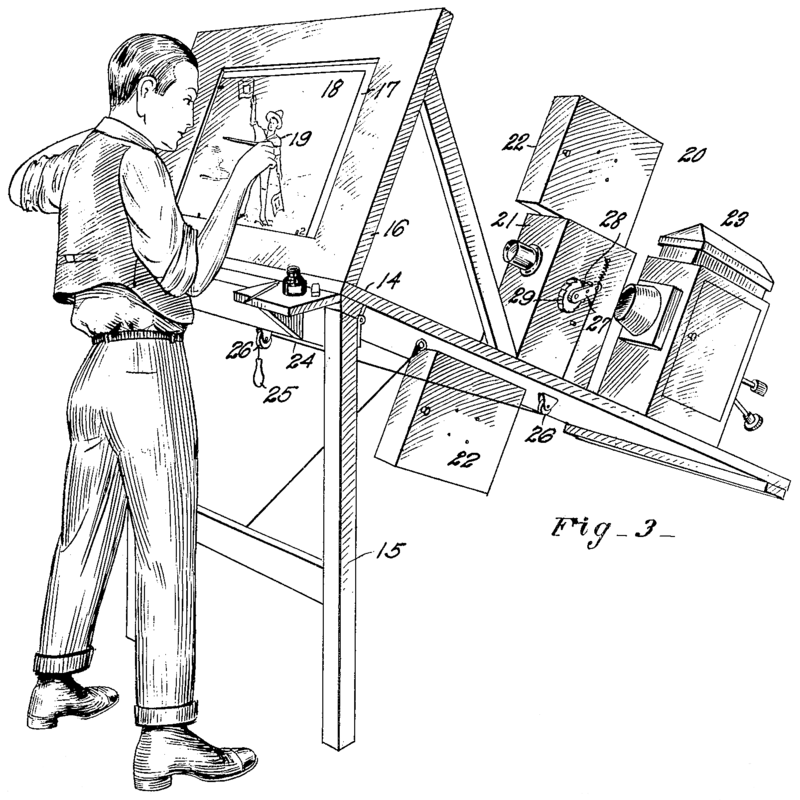Max Fleischer, The Father Of Modern Animation
Generally when people think of cartoons, in the sense of animated films, they assume that all the real pioneering work was done by Walt Disney back in the 20’s of the last century, but this is absolutely not the case. In fact almost all the development of techniques and styles were the work of a man who is now hardly remembered by people outside the world of animated films, a certain Max Fleischer.
The list of techniques and tools that he invented or developed is enormous, and his influence on what we now see every day on our screens is almost entirely due to the amazing imagination and skill of this remarkable man.
I shan’t bother to give a sort of potted biography of him here. What I shall be looking at here are the main threads of his development as an animator and an inventor of all manner of very significant techniques and aids to making and watching such cartoons.
OK, it is a bit of a give away I suppose, yup, he was the creator of Betty Boop among other famous cartoon characters.
He was also responsible for such famous cartoon characters as Popeye, Koko the Clown and numerous other now forgotten characters who were the result of his work, oh and he was also responsible for the first cartoons of good old Superman as well.
I shall be giving you examples of these various cartoons later in this post, so bear with me as I discuss some of his other major contributions to the art of animated films.
The first, and possibly the most significant was the invention of a gadget called the Rotoscope.
The Rotoscope:
This is a device that allows the animator to produce cartoons that are not jerky or disconnected. The way it works is that behind the transparent film on which the artist draws each frame there is a projection of the earlier filmed frames, or the background of the film.
Effectively what happens is that the artist can see the frame that came before the one he is working on, so he can draw the character he is animating with just exactly the differences needed to produce a smooth motion when it is all put together in the film.
Amazingly he invented this device in 1915! Up till then, most animations had been very jerky as the artist simply had to guess the exact position of the legs (or whatever section he was animating) in the previous frame. Not ideal you will agree.
Way back in the 80’s and 90’s of the last century, I used exactly that technique on my Amiga computers to produce smoothly flowing animations, as the software I used gave me the possibility of showing me the previous 1 to 4 frames in a sort of shaded out version, thus I could see exactly how my changes to the character I was drawing fitted to the previous frames. A real boon I found it all.
This technique is still used by animators all over the world, though obviously they now do it with computers rather than that wonderfully bulky machine, but the principle is exactly the same.
On a less important level, he also invented the bouncing ball that shows you what word you should be singing when you are singing along with an animation, or indulging in that dreadful thing known as Karaoke.
He was also a whizz at combining animated drawings with live action “real” things. So for example, a real singer would be shown interacting with an animated character. He wasn’t the only one doing this, but he perfected various techniques that enabled him to produce absolutely integrated real actors and drawn ones.
On this topic, an advertising film he made for Oldsmobile Autos is a case in point, it is absolutely aimed at adults in every way, it contains totally unambiguous references to sex, seduction, jealousy and so on… All very strange and absolutely not what one expects from a major cartoon studio producing films for general distribution.
He also invented the technique of Tweening, which is a system whereby the highly paid expert animators draw the images that are at the beginning and end of any movements (Key Frames), and less well paid Tweeners draw all the frames in between those key frames.
So, l hope this has given you a rough idea of how important he was in the development of the cartoons we see today, and that you realise the huge difference between his work and that of Disney (whom he loathed, referring to him regularly as “That son of a bitch”).
So, now lets look at a couple of his more typical films, starting off with a great example of how he went about combining live action with animated action. By the way, the guy doing the drawing in this film is the man himself.
So here we go, with the tantalising fly.
Amazing, isnt it? And that was made in 1919 too!!
And now, (drum roll please) we have the man himself, Popeye.
Not much I can say about this, except to point out that it is in its own subtle way, much more adult that you would at first expect.
And now, last, but absolutely not least, the first real Super-Hero, Superman!!!!
So, I hope you found this brief wander through the work of Max Fleischer both interesting and pleasing and that it will encourage you to hunt around for more examples of his huge body of work.



The remarks told to me by family members were that Max Fleischer regarded Walt Disney as an “interloper,” and a nuisance who came up every once in a while when he came to New York on business. He would stop by Fleischer Studios to see what was going on, and hang around the entrance to the building where the studio was located, 1600 Broadway, waiting for Fleischer’s Animators to come out on their Lunch Hour. He would then talk to them and try to lure them out to Los Angeles to work for him. This was a frustration for Fleischer since he had an investment in training these people only to have Walt gaining access to the results of his training and “secrets.” But in all fairness, those who left to work for Disney did so of their own accord since Disney was younger, more energetic, and most of all offered a sense of adventure on the west coast that appealed to young artists. So it was a matter of choice, to stay with a stable studio, or take a chance for less money and an uncertain continuation of employment.
LikeLike
That is an interesting aspect of the story, for which I am grateful to you for sharing it with us. I had never thought of how Disney recruited his staff
LikeLike
Of course in the Disney version of history, this is not touched upon. However, it worked both ways. While it seemed that Walt “lured” Fleischer’s people away, they did so of their own doing. Berny Wolf, who I worked with told me that he was happy at Fleischer Studios, but what Walt offered sounded more adventurous, going out to Los Angeles. And the things he was doing were exciting to young Animators eager to do more. So it was a matter of realization of what each Producer was doing with animated cartoons combined with a contrast in ages, energy, and vision.
LikeLike
So, animation in those days was an exciting business, and the place where Disney was working was in its own way, an exciting place. I agree with your thoughts on why people went to Disney, I would have too.
LikeLike
It’s often tempting to assume that when one sees the fun and frolic on screen that making the cartoons was fun and exciting. To a certain degree it was, but not for the most part, and not for a lot of the people working in the field then.
It was The Depression then, and wages were low. It was because of this, the cartoon studios could afford to hire a large number of Assistants and Inbetweeners to finish off the Animator’s work. One of the things that is most impressive about cartoons of this era is their fluid action due to the many drawings that they could afford to make in the process.
Those who worked in the lower levels of Inbetweening, Inking, and Painting found the work grueling especially when production was being pushed. This was the case that led to the Strike at Fleischer Studios in 1937. Disney had a similar Strike in 1941. Understand that the product is fun, as it’s supposed to be. BUT it IS a lot of tedious work. Patience and endurance was, and continues to be “the name of the game.”
LikeLike
I know all about how tedious making animateions can be, Whle I was at St Martins Art School I made a cartoon, it was all of 3 minutes long, and I know exactly how long that is in seconds. It was tedious beyond words making the drawings for that.. 16 drawings per second I worked at, so it ended up being 960 drawings per minute, so 2880 drawings in total. (O:
LikeLike
What you did would have been about half the work done during the Silent Era, when the frame rate was 16 fps. But the frame rate was raised 50% when sound came in, or 24 fps, which has continued to be the standard. So with that, you’d have to have made in the neighborhood of 1,350 drawings.
LikeLike
The mind boggles!! It was bad enough doing it at 16 per second… The idea of 24 per second is too much!!
LikeLike
That was the key to the fluid animation that amazed people. It took a lot of drawings to match what live action cameras did to create motion pictures. Here it was done by hand, frame by frame.
LikeLike
And it was (and is) a hell of a lot of work!!
LikeLike
A lot of work divided among a lot of people in order to make the picture. As it is said, “Many hands make for light work.”
LikeLike
True, true…….
LikeLike
What needs to be understood as well is that it was a collaborative effort. This is something all of the old timers would tell you. The Youngsters discovering these classics need to understand that.
LikeLike